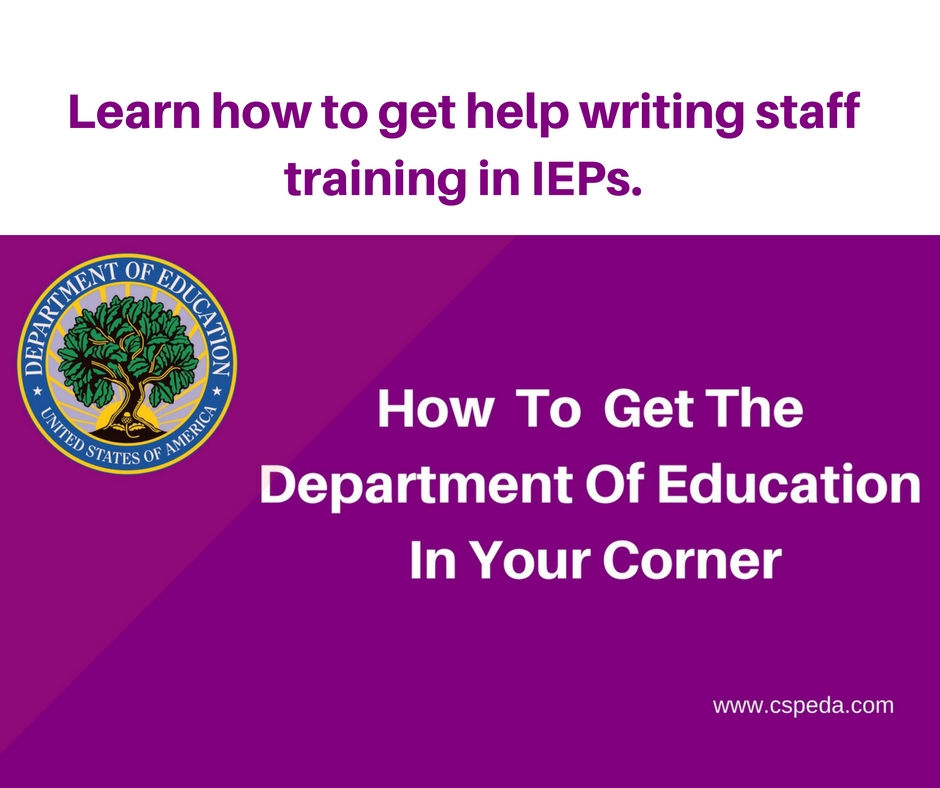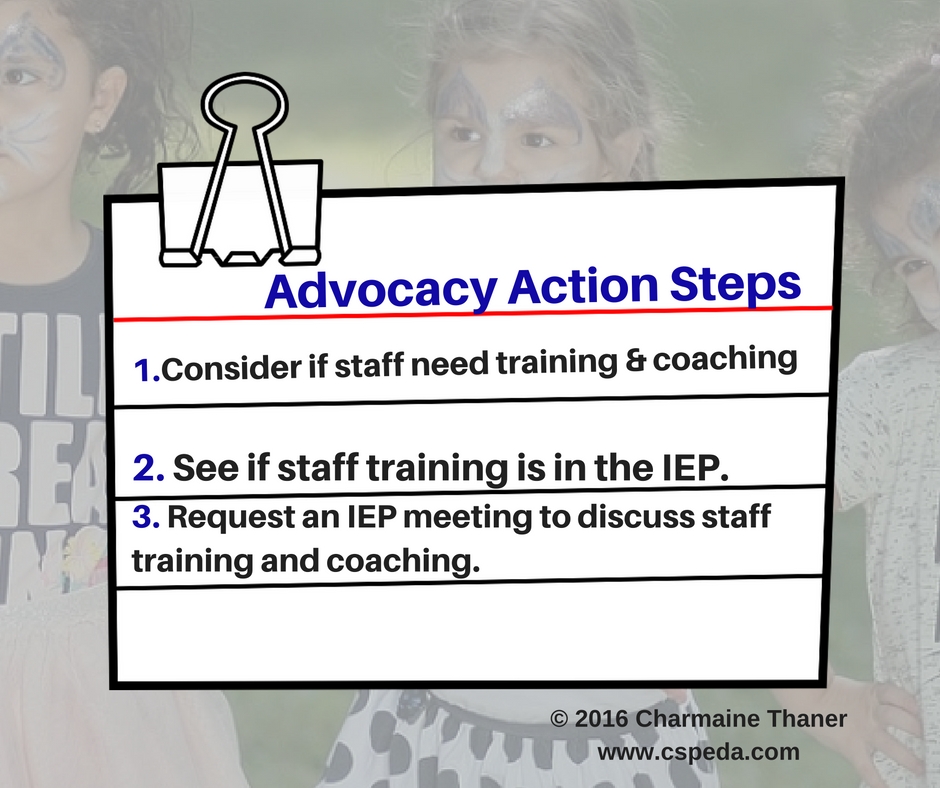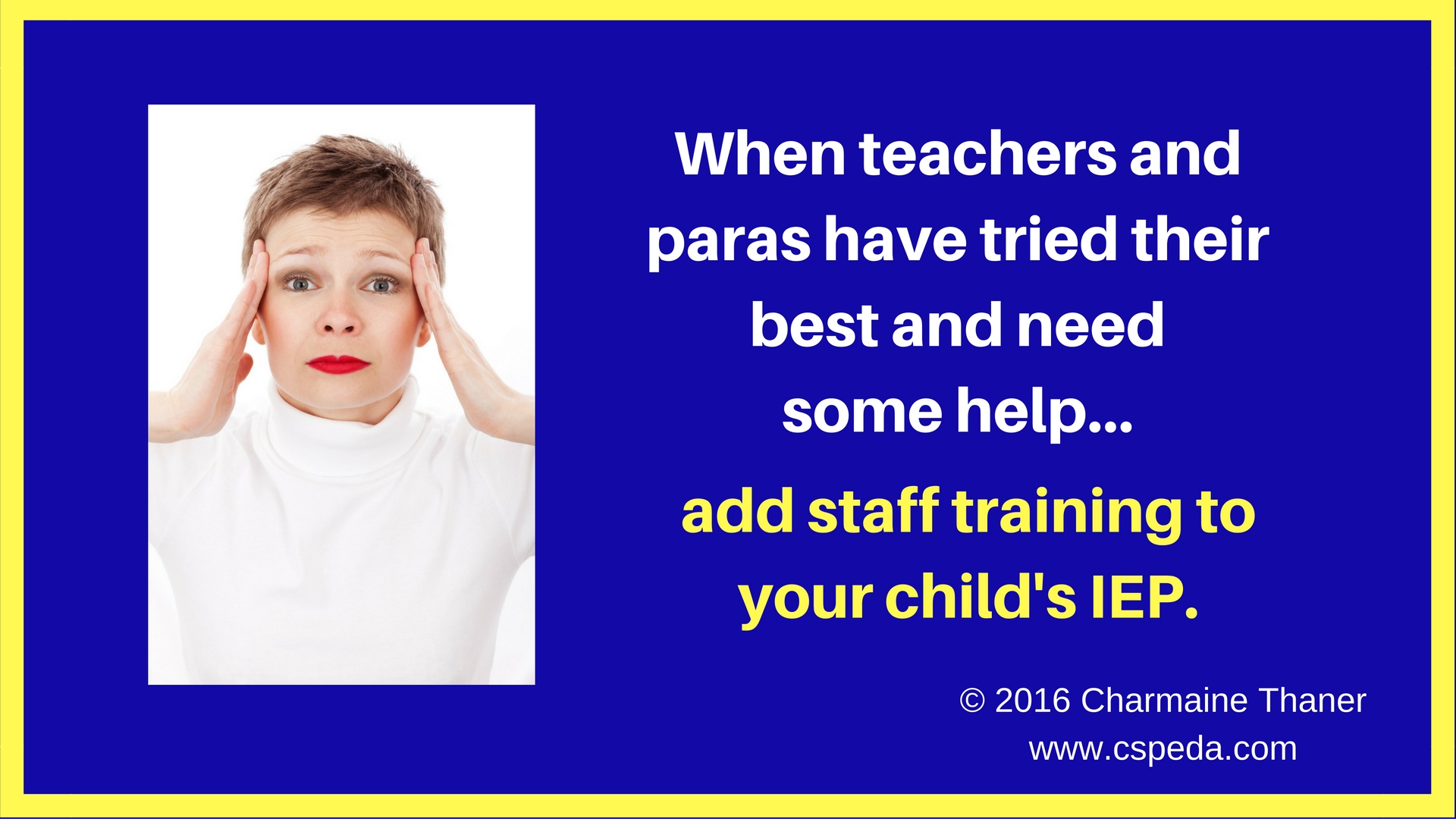You’d Never Guess How to Get the Dept. of Ed. in Your Corner
How awesome would it be to have the federal Department of Education in your corner when asking the school to do something they haven’t done before?!
Today I’ll share with you an important letter from the federal Department of Education about adding training for staff in the IEP. You’ll want keep this letter in your back pocket.
Want to watch video of this post? Click here. Rather just listen to audio? Click here.
In this week’s blog post we’re going to look at how to make sure the staff have the necessary training and support to understand the messages your child’s behavior is sending and know how to put any needed positive behavior supports in place.
We know just because positive behavior supports can be written in your child’s IEP, it doesn’t necessarily mean everyone will know how to put those supports in place.
I’m glad you’re here today because even though our examples we’ll use are about supporting students with possible behavior challenges, the inside tips you’re going to learn can apply to any area where the school staff can also get support they need.
Instead of first writing a behavioral intervention plan for a student, why don’t we start by looking at the skills of the staff. Maybe the “problem” isn’t within the child. Maybe we first need a support plan for the staff – where they can receive any necessary training and coaching.
And, I’m not saying this in a mean way. Just like you want your child to be supported at school we need to make sure the people who work with him are also supported.
At the end of this blog post I’ll tell you about a free tool, that’ll you’ll want because this will help the school year be awesome, so stay with us. Hint: you’ll find this at the link, Click here.
Did you know training and coaching for staff can be written in your child’s IEP?
We often think IEPs are just for the child, when in fact people who work with your child can also receive support.
And this isn’t meant to be a judgment. We can’t expect the teachers and para educators to know everything there is to know about all the instructional and behavior supports a student may need.
Please don’t throw the need for staff training in the teacher’s face. That won’t earn you any collaboration points and can end up hurting your child.
We don’t want our children to be judged because of the needs they have, and we don’t want staff to feel less capable because they need some additional training and/or coaching.
Most adults receive periodic training at their work and this isn’t seen as a negative, but an important part of professional development.
Want to know where supports for staff can be written in the IEP?
It’s in a place that’s usually near the end of the IEP document – under Supplemental Aids and Services. After reading this article, pull out your child’s IEP and see what’s written in that section.
Now we know Districts and states use many different kinds of IEP forms. You may not see a section labeled Supplemental Aids and Services, it may just be called Services or Services & Other Considerations.
Why should you care about what if anything, is written in the Supplemental Aids and Services section of your child’s IEP?
Because this is where it can be in writing that the staff need additional training and coaching so you child can:
1) will make progress on their goals,
2) participate in general ed curriculum including extra curricular activities and
3) be educated with students without disabilities to the maximum extent appropriate.
Now, just a note of clarification: supplemental aids and services are not the same as Related Services.
And we wonder why the special education system is so confusing to parents…
Related services are provided so students can benefit from special education services.
Examples of related services are things like OT, PT, speech, transportation, counseling services, school nurse services, and many more.
One related service that hardly ever gets mentioned at IEP meetings is Parent Counseling and Training – but that topic will be saved for another video.
I think what happens is, most IEP teams write down the special education and related services students need, but there is little if any discussion of supplemental aids and services.
Which can mean there is little or no discussion about any training and coaching needs for the staff.
When staff training and coaching are needed for whatever reason, the specifics of that training and coaching must be written in your child’s IEP. Remember if it’s not written down, you can’t hold the school accountable for it.
For instance, if staff need to be trained how to use the student’s augmentative communication device – that should be written in the IEP. Sometimes the school personnel need training and/or coaching on understanding what a child’s behavior is communicating and how to put positive behavior supports in place. If training and coaching for people who work with your child is necessary, it needs to be written in the IEP.
If staff do not have the proper training and coaching to provide the supports your child needs or to ensure your child will receive a free, appropriate public education this can potentially be a serious issue.
There’s a chance if you bring up staff training and coaching to an administrator they might get defensive and say that’s a personnel issue and not an issue for the IEP team to decide.
When you are requesting school staff to do something they have never done before, It’s important you have some data, document, and/or a compelling story to share to support the request you are making.
How would you like to have the federal Department of Education in your back pocket, ready to help you get the necessary staff training in place?
Well, you’re in luck! I’m always on the look-out for new resources for you. It just happens that just a couple weeks ago, on August 1, 2016 ago the Dept. of Ed. released a letter of guidance to local school districts in supporting students with behavior needs – and reminding Districts what the federal law says about staff training.
You can print your own copy of this 16 page letter, Click here.
Now, I know everyone’s not as much of a special education nerd as I am and the thought of reading a 16 page letter from the federal department of education is not something you’re thrilled about (boring)–
At least look at the bottom of page 7 of this letter from the federal Department of Education and read what is written about Supports for School Personnel.
Chances are there are not any supports for the staff written in your child’s IEP.
If you want to request that be added to the IEP you’ll need to request an IEP meeting to discuss staff training and coaching.
My suggestion is to share the original 16 page letter ahead of time with the other members of the IEP team.
A new tool I mentioned at the beginning of this post will be a big help as you compose your written request for an IEP meeting. This is a free resource that’s available for a limited time on my website.
You’ll discover what to say and how to make requests so they are heard and acted on. Click here and download A Better Way To Be Heard.
Your 3 Advocacy Action Steps are:
- Consider if staff need training
- Check IEP, if training is included
- Request an IEP meeting to discuss staff training
When we work together your child’s strengths will be built on, he’ll actively participate and learn in general education classrooms, and he’ll be seen as a valuable part of the school community!
You can set up a free 30 minute phone consultation with me, email me at charmaine@cspeda.com
You can also get in touch with me on my website www.cspeda.com, and on my facebook and pinterest sites.
Until next week, take care.
Charmaine






